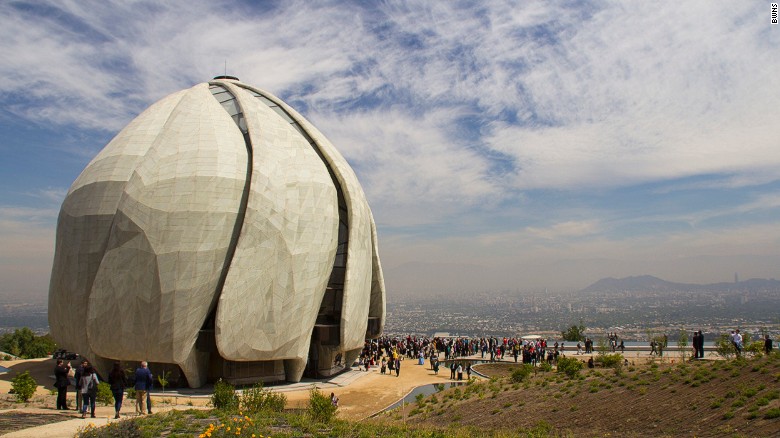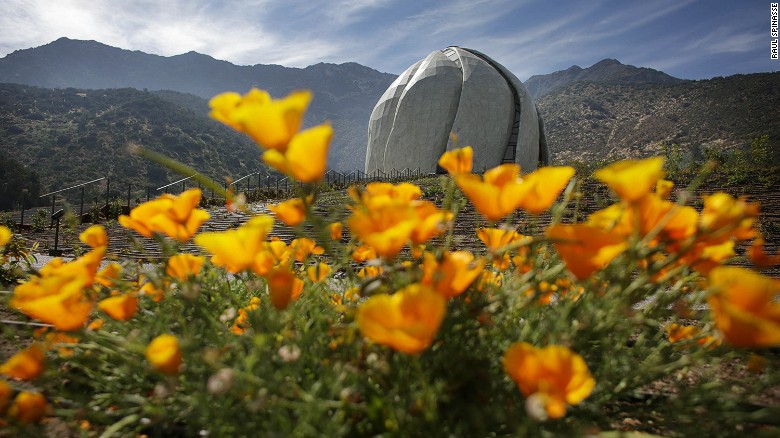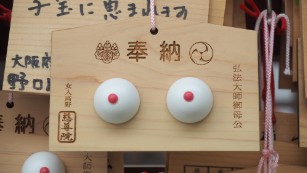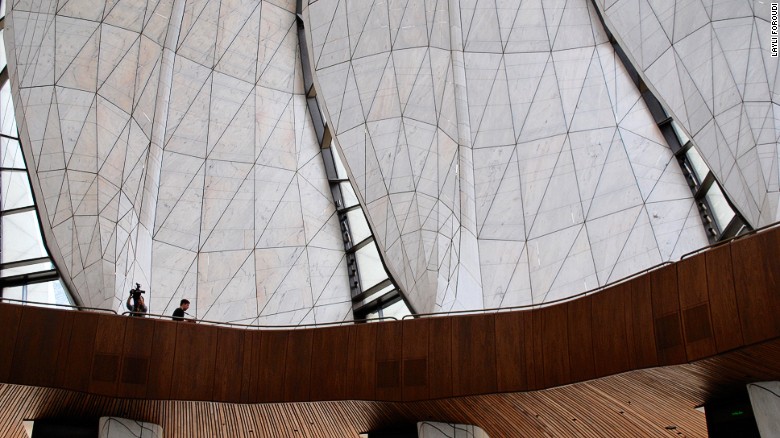Temple For a New Age? The temple that welcomes all religions, or none at all
"That
dimple you see over there," said Siamak Hariri, pointing to the surface
of his award-winning structure nestled in the Andean landscape on the
outskirts of Santiago, "that little subtle inflection, the way the line
goes round is very deliberate -- do you find that satisfying?"
I nodded.
"And
you're not Chilean" he responded, alluding to an aspiration of his
firm, Hariri Pontarini Architects, for the Bahá'í Temple in Chile: they
wanted to create a universally attractive form.
Openness, in spirit and in form
Previously
a barren golf course owned by the elite Grange School in Santiago, the
10-hectare site -- which took nine years to find - has been transformed
into a space envisioned to be open to all, regardless of background,
religion, gender, or social standing.
"This
is a place that is welcoming all the religions, or if you have no
religion," said Hariri, who is a Bahá'í himself, during the opening of
the Temple in October 2016.
"It's an architectural challenge. How do you give something a form that means this?"
In
spirit and in structure, the building was to embody the unity of
mankind, which is a central belief of the Bahá'í Faith, an independent
religion founded in 19th century Iran.
The Chile Temple is the final Bahá'í continental temple to be built, joining eight others, including the Temple for North America in Wilmette, Illinois, and the Lotus Temple in New Delhi, India.
A
Bahá'í Temple has only a few criteria: it needs to be "a nine-sided
domed structure with nine entrances to symbolically welcome people from
all directions of the earth for prayer and meditation."
Faced
with this architectural challenge, Hariri and his creative team did not
want to take inspiration from other buildings. It could not look like a
mosque, a synagogue or a church as this may alienate certain people.
Equally,
drawing on the culture of one or some of the indigenous communities of
Chile was not a priority, as it would involve excluding others. "They're
not all the same, you can't just lump everything together," Hariri told
CNN, "if I went Quechua, the Mapuche would not be represented, and so
on. It is very delicate."
In search of a "feeling"
Rather, they were in search of a "feeling" and aesthetic cues were taken from taken from outside of architecture.
"We
looked to organic forms: a cheekbone is a universal thing, right?"
asked Hariri rhetorically, later mentioning the veins of a leaf, the
curve of a woven Japanese basket, and the folding of robes in paintings
of the old masters.
On some days,
the Temple looks like it has always existed as part of its organically
formed backdrop, the Andes. The radial gardens, designed by acclaimed
Chilean landscape architect Juan Grimm, are made to blend into the
Andean environment, creating a "garden that has no limits."
Above
all, light is the defining trope of the structure: Hariri feels that
"light is universal" and can act as a symbol of unity. The temple was
designed to cause visitors to feel like they were gazing up at the
heavens or turning towards the light, like a plant moves to face the
sun.
Nine wing-like panels of
translucent cast glass subtly spiral to form the temple dome, converging
90 feet above the ground with a clear glass oculus holding a Bahá'í
symbol known as "the greatest name." Daylight passes through the glass
and floods the white marble interior and after sundown, light from
within causes the structure to quietly glow in the night.
"The temple is like a drapery of light," says Hariri, "It's not light passing through -- it's captured light."
Earthquake resistant
In
pursuit of this "feeling", the multidisciplinary team adopted
three-dimensional modeling software CATIA, made for industrial design
and aerospace engineering and rarely used in architecture, which was a
daring move and "breathtakingly hard" 13 years ago at the beginning of
the project.
Another
technical feat was the installation of a pendulum isolation system to
make the building resistant to seismic activity. Three universities --
in Canada, Los Angeles and Chile -- collaborated to create a system that
allows for 600 millimeters of movement, so that the whole building
rocks and returns to the center in case of an earthquake.
Coexisting
with innovations in technology and machine-to-machine production is an
artisanal quality, created by the use of ancient materials like bronze,
cast glass, and stone.
The bronze
doorways are molded by hand, and the cast glass on the exterior of the
Temple was invented using melted down test tubes and petri dishes in the
studio kilns of Jeff Goodman, a Canadian glass artist known for his
ornate blown-glass creations.
Over
30,000 square meters of glass were fired in a bespoke factory of six
kilns to produce around 1,100 glass panels of various shapes and sizes,
which slot into place to form the exterior of the "wings," supported by
steel frames coursing through the edifice like the veins of a leaf.
"It
is a very deliberate intersection between the ancient and the absolute
new. That's not just architectural, it's philosophical," mused Hariri,
intimating the Bahá'í belief that all the religions of the past and
future are one, "this extension both forward and back is very symbolic."
Faith in the theories
Looking
at the finished structure, Hariri is happy and perhaps relieved: there
was no guarantee that the computer modeling would translate into the
desired effect of "embodied light," captured in the glass.
"That
was one of our biggest worries, would that in fact happen -- it's a
theory!" he breathed, "You hope it does, that [the light] does kiss that
marble."
The Temple is built to
last 400 years: time will tell if the theory of a universally attractive
form holds, too. So far, so good.
TradCatKnight Radio: "Catholicism vs. New Age"




